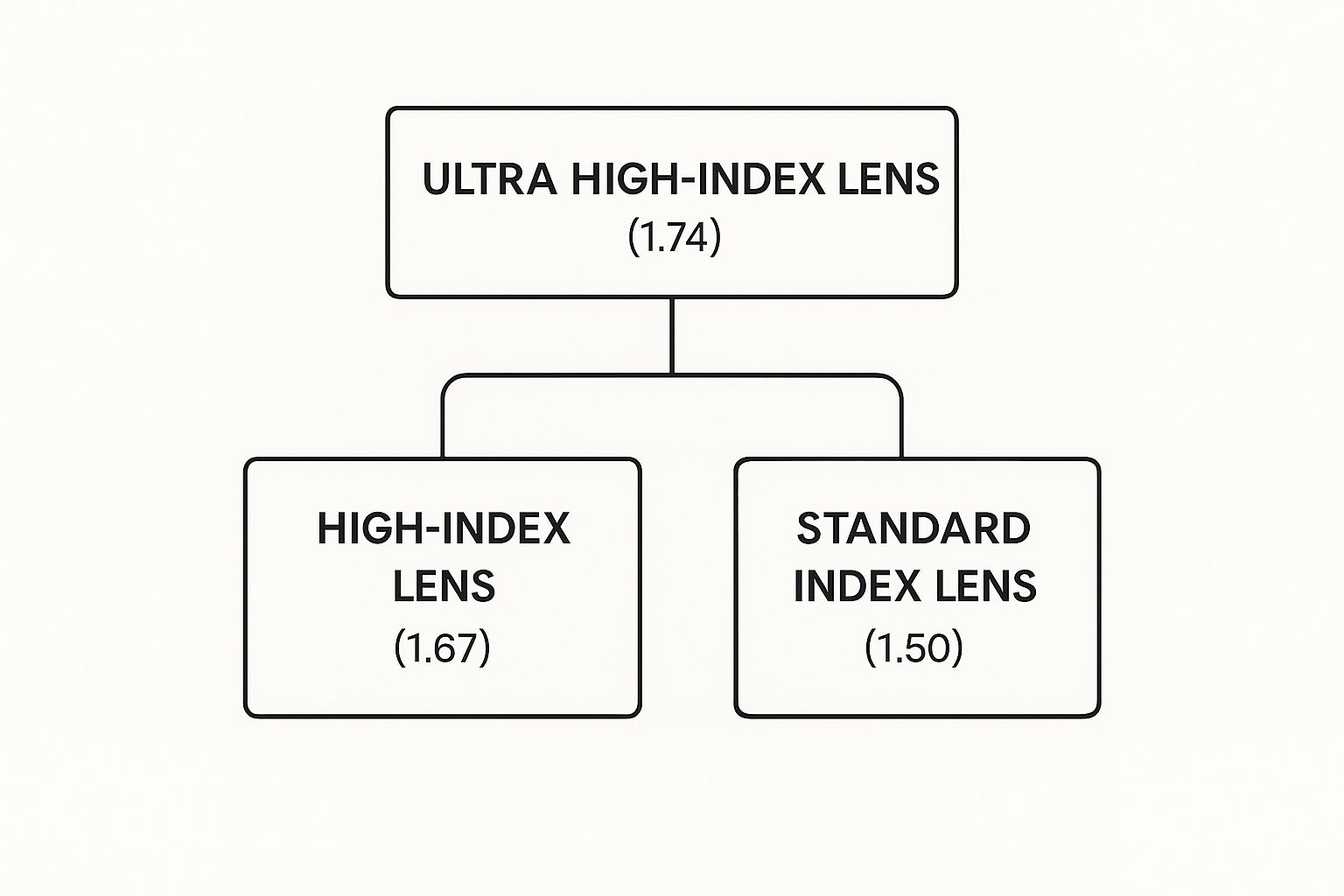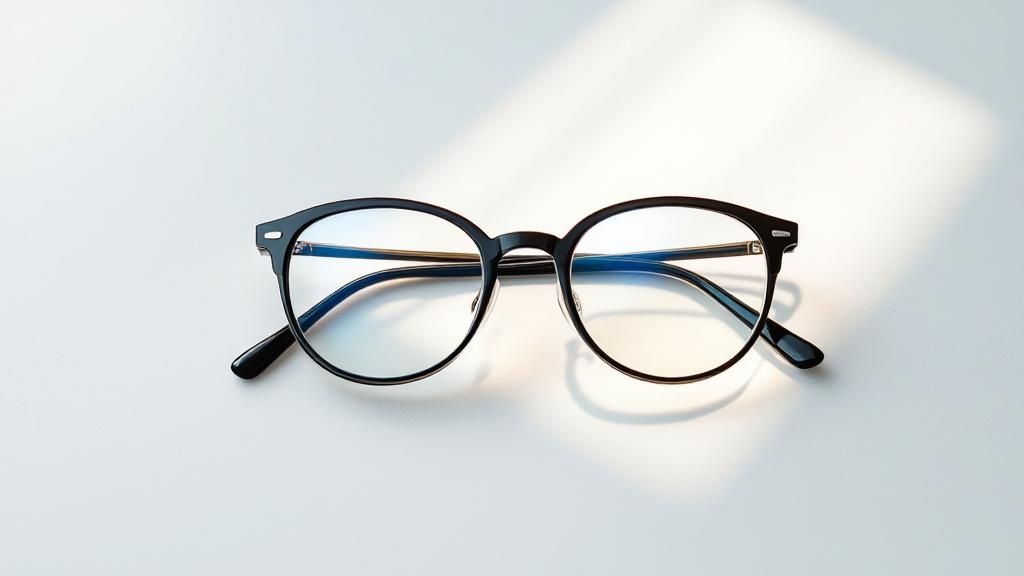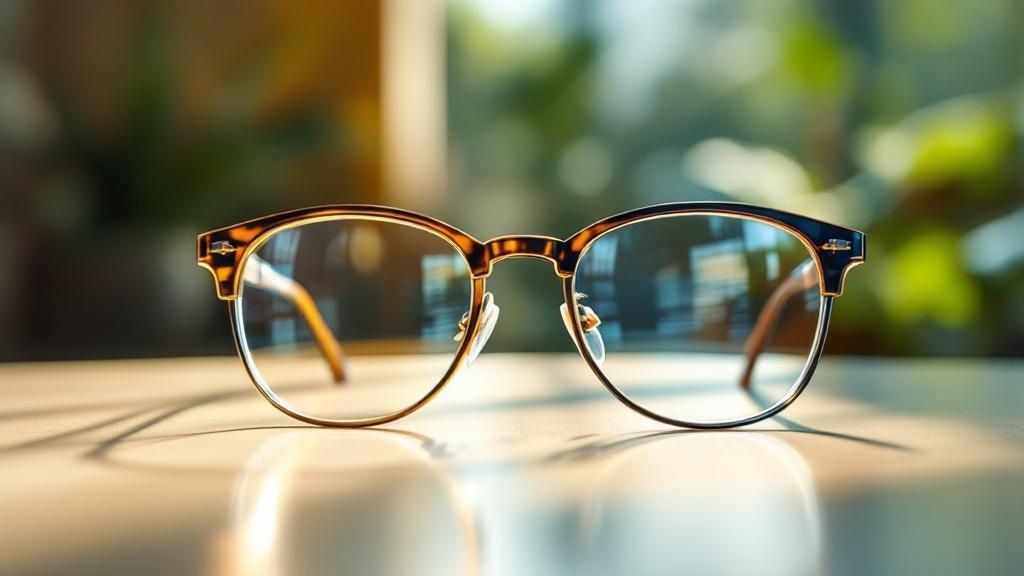
A Guide to Lens Options for Glasses
Picking the right lenses for your glasses can feel like you're staring at a massive menu with a hundred different options. It's overwhelming, but it doesn't have to be. Really, it just comes down to matching the right tech to your lifestyle, your prescription, and your budget. For instance, if you have a strong prescription, high-index lenses are a game-changer. If you stare at a screen all day, blue light filtering is your best friend.
Decoding Your Prescription and Lens Materials
Before we get into all the fancy coatings and special features, we need to talk about the lenses themselves. The material your lenses are made from is the absolute foundation of your glasses. Think of it like building a house—a strong, lightweight foundation lets you build a better, more comfortable home. It's the same idea with your eyewear. Your journey starts with your prescription, which points you toward the best material for clear, comfortable vision.
The global demand for better vision is huge. The spectacle lens market was valued at around $53.71 billion and is only expected to get bigger. This growth is all about the rising need for vision correction and the incredible advancements in materials like plastic, polycarbonate, and high-index options. You can find more insights about the global spectacle lens market and its drivers online.
Understanding Lens Index
You’ll hear the term "index" thrown around a lot. It's just a number that tells you how well a material bends light. A higher index means the material is more efficient at its job.
So what does that mean for you? A higher index lens can correct the same prescription while being much, much thinner and lighter. It’s how we get away from those thick, heavy "coke bottle" lenses that were common with stronger prescriptions.
This image shows you exactly what we mean. As the index number goes up (from a standard 1.50 to a super-thin 1.74), the lens gets dramatically slimmer.

It's a big deal for both how your glasses feel on your face all day and how they look.
Common Lens Materials
So, what are your choices? Let's break down the most common materials. Each one has its own unique mix of clarity, weight, and toughness, making it a good fit for different people and activities.
- Standard Plastic (CR-39): This is the classic, old-school optical plastic. It has fantastic optical clarity and is super affordable. If you have a mild or moderate prescription and lens thickness isn't a big worry, this is a solid, reliable choice.
- Polycarbonate: This material was actually first developed for things like astronaut helmet visors, which tells you everything you need to know about its durability. It’s incredibly impact-resistant, making it the go-to for kids' glasses, safety glasses, or anyone with a really active lifestyle. Bonus: It's also thinner and lighter than standard plastic.
- High-Index Plastics: These are the sleek, modern options (you’ll see them listed as 1.61, 1.67, and 1.74). If you have a strong prescription, these materials are your best bet. They produce the thinnest and lightest lenses possible, which means maximum comfort and a much better look, especially in today's stylish, minimalist frames.
Here’s a quick-glance table to help you compare the main options.
Lens Material Comparison At a Glance
This table compares the most common lens materials based on key factors like impact resistance, clarity, weight, and UV protection to help you quickly identify the best starting point for your needs.
| Material | Key Benefit | Best For | Clarity (Abbe Value) | Impact Resistance |
|---|---|---|---|---|
| Standard Plastic (CR-39) | Excellent optical clarity & low cost | Mild to moderate prescriptions, budget-conscious buyers | High (58) | Good |
| Polycarbonate | Superior impact resistance | Kids, sports, safety glasses, and active lifestyles | Lower (30) | Excellent |
| High-Index Plastic (1.67+) | Thinnest and lightest profile | Strong prescriptions, cosmetic appeal, and maximum comfort | Good (32-42) | Very Good |
Ultimately, choosing the right material is the first and most important decision you'll make. It sets the stage for everything else, ensuring your new glasses are not just clear, but comfortable and perfectly suited to you.
High-Index Lenses for Stronger Prescriptions
If you have a strong prescription, you know the drill. Thick, heavy lenses that magnify your eyes, feel like a lead weight on your face, and limit your frame choices. For a long time, correcting significant nearsightedness or farsightedness meant you were stuck with the dreaded ‘coke bottle’ look. Thankfully, those days are over thanks to high-index lenses.

So, what’s the secret? Think of it like this: a high-index lens is simply much more efficient at its job. It's made from a special plastic material that can bend light more effectively than standard lens material. This superior light-bending ability, measured by its "refractive index," means it can achieve the same vision correction with much less material. The end result is a lens that's dramatically thinner, lighter, and way more comfortable.
Decoding High-Index Numbers
High-index isn't a one-size-fits-all solution; it comes in different levels of thinness, usually categorized by numbers like 1.61, 1.67, and 1.74. The rule is simple: the higher the number, the better the material is at bending light, which means your lens can be even thinner.
Picking the right index really comes down to your prescription strength and how much you care about the thickness. Your optician is the best person to guide you, but here’s a quick rundown to get you familiar with the options:
- 1.61 High-Index: This is a fantastic starting point for moderate prescriptions. You'll see a definite improvement in thickness and weight compared to the standard 1.50 or polycarbonate lenses.
- 1.67 High-Index: For stronger prescriptions, this is often the sweet spot and one of the most popular choices. It delivers a major upgrade, creating lenses up to 45% thinner than basic plastic.
- 1.74 High-Index: This is the top of the line—the thinnest and lightest plastic lens material you can get. If you have a very strong prescription and want the sleekest, most comfortable result, this is your go-to.
Why Thinner and Lighter Matters
The move to high-index lenses is about more than just aesthetics. Lighter glasses mean less pressure on your nose and behind your ears, making all-day wear much more pleasant. Thinner lenses also help reduce the visual distortion—that "bug-eye" or "tiny-eye" look—that can happen with strong prescriptions, allowing your eyes to appear more natural behind your glasses.
A critical point to keep in mind: as the lens index gets higher, the material naturally becomes more reflective. Because of this, an anti-reflective (AR) coating is pretty much a mandatory partner for any high-index lens. It's what ensures you get that crystal-clear, sharp vision you're paying for.
Ultimately, high-index lenses give you freedom. They open up a world of frame styles, from delicate metal designs to modern rimless options, that might have been off-limits before. By getting to know these lens options for glasses, you can confidently pick a material that gives you both fantastic vision and all-day comfort.
Essential Lens Coatings for Better Vision and Durability
Once you've picked the right material for your lenses, the next conversation is about coatings. Think of these as powerful, invisible upgrades that supercharge your glasses, boosting both their performance and how long they last. These are ultra-thin layers applied right onto the lens surface to tackle common frustrations like glare, scratches, and smudges.
Lens coatings are honestly one of the most practical and impactful lens options for glasses you can choose. They work behind the scenes to make what you see every day clearer and much more comfortable. Let's walk through the essential coatings that really deliver the most bang for your buck.
The Power of Anti-Reflective Coating
Ever been annoyed by the reflection of your own eye in your glasses? Or maybe you've been blinded by the glare from an oncoming car's headlights at night. That’s exactly what anti-reflective (AR) coating is designed to fix. This microscopic layer is engineered to let more light pass through the lens instead of bouncing off its surface.
The result is a huge reduction in glare from all kinds of sources, from overhead office lights to your computer screen. This doesn't just make your vision sharper and more comfortable—it actually makes your glasses look better, too. By getting rid of those distracting reflections, AR coating makes your lenses look almost invisible, so people can see your eyes more clearly.
Key Insight: An anti-reflective coating is a non-negotiable for high-index lenses, which are just naturally more reflective. Without it, you’ll be robbed of their superior optical clarity because all those reflections will get in the way of your vision.
Protecting Your Investment from Daily Life
Beyond just improving how well you see, some coatings are all about protecting your lenses from the reality of daily use. Glasses are an investment in your sight, after all, and you want them to hold up.
Two of the most valuable protective coatings you can get are:
- Scratch-Resistant Coating: Look, no lens is completely scratch-proof. But this hard, clear coating adds a crucial layer of defense against minor drops, accidental rubs, and the wear and tear of daily cleaning. It's a must-have, especially for softer materials like standard plastic that are more likely to get scuffed.
- Hydrophobic and Oleophobic Coatings: These two are usually bundled together and work like a non-stick pan for your lenses. The hydrophobic part repels water, making droplets bead up and roll right off. The oleophobic part resists oil and grease, which makes it much harder for fingerprints and smudges to stick. That means your lenses stay cleaner for longer and are way easier to wipe clean when they do get dirty.
Many of us also grapple with digital eye strain from staring at screens all day. If that sounds familiar, learning about what blue light lenses do and how they protect your eyes can be a game-changer when building your perfect pair of glasses. These specialized filters can be combined with other key coatings for truly comprehensive protection.
Protecting Your Eyes in the Digital World
Let's face it: we spend a huge chunk of our day staring at screens. From our phones and tablets to the big monitors at work, digital devices are a constant. This has led to a major uptick in what's known as digital eye strain and a lot of talk about the effects of blue light.
So, what is it? Blue light is a high-energy, short-wavelength light that beams out from LED screens. Too much exposure can leave your eyes feeling tired, dry, and can even trigger headaches.

To fight back against this fatigue, a specialized blue light filter has become an incredibly popular choice for glasses. Think of it like a selective bodyguard for your eyes. These lenses are engineered to block or absorb a specific amount of the blue light spectrum before it ever hits your retina, which can seriously ease the discomfort of long hours in front of a screen.
How Do Blue Light Lenses Actually Work?
These lenses come in a couple of main varieties. Some have a very noticeable yellowish or amber tint. While the color is obvious, these are incredibly effective at blocking a high percentage of blue light.
Others use a more subtle approach, with an advanced filter baked right into the lens material. These look almost perfectly clear to the naked eye, with maybe just a faint hint of a tint if you look closely.
Which one is right for you? It really comes down to your personal sensitivity and daily habits. If you're a gamer, a programmer, or anyone who spends eight or more hours glued to a monitor, the stronger tint might offer more noticeable relief. For general office work or just casual scrolling, a nearly-clear filter usually does the trick without messing with your color perception.
A big reason people worry about blue light is its potential to mess with your body's natural sleep-wake cycle. When you're exposed to it at night, it can signal your brain to stop producing melatonin, making it much harder to drift off to sleep. Popping on a pair of blue light glasses in the evening can help your body wind down naturally.
This focus on eye health is a huge driver in the global eyewear market, which was valued at a staggering $158.53 billion. The industry is projected to keep growing, largely because more and more people are becoming aware of digital eye strain and are looking for real solutions like blue light filters.
At the end of the day, if you’re an office worker, a student, or really anyone who logs significant screen time, these lenses are a smart investment in your visual comfort. To dig a little deeper into this, check out our guide on the health benefits of wearing blue light blocking glasses.
Lenses That Adapt to Your Environment
What if one pair of glasses could seamlessly handle every lighting condition you encounter? Imagine going from your dimly lit office straight out into the brightest beach day without ever fumbling for your sunglasses. That’s the brilliant idea behind adaptive lenses.
This smart eyewear tech is a fantastic choice for anyone who moves between indoor and outdoor settings a lot. If you want the sheer convenience of a single, do-it-all pair of glasses, these are for you.
Two major players dominate this space: photochromic and polarized lenses. While both are excellent lens options for glasses you'd wear outside, they solve very different problems. One reacts to light itself, while the other is all about cutting glare, giving you two distinct ways to make your eyes more comfortable.
Lenses That Change with the Light
You've probably seen photochromic lenses in action, even if you didn't know the name. You might know them by the popular brand name Transitions. These lenses have a pretty remarkable trick up their sleeve: they’re perfectly clear indoors but automatically darken when the sun's ultraviolet (UV) rays hit them.
How does it work? Think of it like this: the lens material contains trillions of microscopic molecules that are sensitive to UV light. When you step outside, these molecules change their shape, causing the lens to darken and essentially become a sunglass. The moment you go back inside, away from the UV source, they switch back to their original state, and the lens becomes clear again.
This technology is perfect for people who value convenience above all else. It completely eliminates the hassle of switching between your regular glasses and a separate pair of prescription sunglasses.
Conquering Blinding Glare
Now, let’s talk about a different kind of visual annoyance: intense, blinding glare. This is the light that bounces off flat surfaces—a wet road, a calm lake, a field of fresh snow. It’s more than just brightness; it’s a specific type of horizontal light that creates visual "noise" and makes you squint.
Polarized lenses are the ultimate weapon against this. Imagine a set of microscopic Venetian blinds built right into your lens, all aligned vertically. These tiny filters only allow vertical light to pass through, which means they physically block the horizontal light responsible for glare.
The difference is night and day. Colors appear richer and more vibrant, details become sharper, and your eyes feel instantly more relaxed. This makes them an absolute must-have for:
- Driving: Slashes the blinding glare from wet asphalt and the reflections off other cars.
- Fishing: Cuts right through the reflections on the water's surface, letting you see what’s swimming underneath.
- Winter Sports: Minimizes the painful, disorienting glare bouncing off snow and ice.
While these adaptive lenses are incredible for handling changing environments, they don't tackle the specific eye fatigue that comes from hours of up-close digital work. For that kind of relief, you might want to explore our guide on how anti-fatigue lenses can help ease the strain of your daily screen time.
What's Next? A Look at the Future of Eyewear
Eyewear has come a long way. What started as a simple medical device is quickly becoming an intelligent, dynamic interface with our world. The lenses we put in our glasses aren't just for correcting vision anymore—they're about enhancing it with tech that's built for modern life.

One of the biggest leaps forward is the development of free-form digital lenses. You can think of them as the high-definition upgrade for your eyes. Instead of being popped out of a standard mold, these lenses are custom-machined point-by-point, using incredibly precise digital measurements of your eyes, your frame choice, and even the unique way you wear your glasses. This level of personalization gives you a much wider, sharper field of view, with far less of that annoying distortion you often get at the edges of traditional lenses.
The Dawn of Smart Lenses
Beyond just getting a clearer picture, we're stepping into the exciting new territory of smart lenses and augmented reality (AR) glasses. This is where things get really interesting. This technology is set to weave digital information right into our field of view, putting everything from turn-by-turn directions and notifications to real-time information overlays right before our eyes. The lenses themselves are becoming the screen.
The big idea here is to get information off the phone in your hand and into your direct line of sight. It creates a much more natural, seamless way to interact with the digital world all around you.
And this isn't just some passing fad; it's a massive force shaping the industry's future. By 2032, the global optical lens market is expected to hit an eye-watering $39.58 billion, which is nearly double where it will be in 2025. This incredible growth is being driven almost entirely by new technologies like smart lenses and the specialized optics needed for augmented and virtual reality. You can read more about the future of the optical lens market and the tech pushing it forward.
This peek into the future shows a pretty clear trend. Our glasses are turning into sophisticated tools that don't just fix our vision but actively change and improve how we see and interact with our environment.
Your Questions, Answered
Jumping into the world of lens technology means learning a lot of new terms. It's totally normal to still have a few questions. Let's clear up any confusion so you can feel great about your final decision.
Can I Just Add Coatings to My Current Glasses?
I get this question a lot, and the short answer is almost always no. High-tech coatings like anti-reflective or scratch-resistance aren't just sprayed on; they're molecularly bonded to the lens in a lab right when the glasses are made.
Trying to add a coating after the fact just doesn't work and would likely damage your existing lenses. To get these benefits, you'll need to choose them when you order a fresh pair of glasses.
Are More Expensive Lenses Actually Better?
Not always. The "best" lens isn't about the price tag—it's about what’s right for you. The real value comes from a perfect match between the lens and your lifestyle.
Think of it this way: a top-of-the-line high-index lens is a game-changer for someone with a very strong prescription, but it’s completely unnecessary for a person with a mild one. Likewise, polarized lenses are a must-have for fishing, but they're an extra expense that an office worker who spends most of their time indoors just doesn't need. The goal is to align the features with your daily life.
Key Takeaway: You're looking for the right tool for the job. You wouldn't use a sledgehammer to hang a small picture frame, right? Apply that same logic when choosing your lens options for glasses—focus on function, not just cost.
How Do I Know What High-Index Level to Get?
Your optician is your best resource here, but you can get a good idea of what you might need by looking at the sphere (SPH) value on your prescription.
Here’s a general guideline:
- Up to +/- 3.00: Standard lenses will usually do the trick just fine.
- +/- 3.25 to +/- 5.00: A 1.61 index lens is a solid choice and will make a noticeable difference in thickness.
- +/- 5.25 to +/- 8.00: Upgrading to a 1.67 index is often recommended for a much thinner and more comfortable profile.
- Above +/- 8.00: A 1.74 index is the way to go for the thinnest, lightest lenses modern technology can offer.
Ready to find the perfect lenses to protect your eyes and sharpen your world? At Spektrum Glasses, we pair cutting-edge lens technology with stylish, comfortable frames designed for how we live today. Explore our collection and see the difference for yourself.
